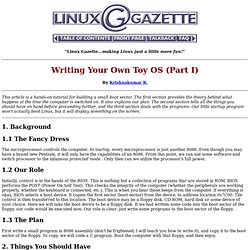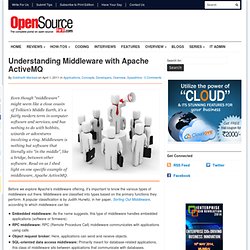

Linux/Unix. Kernel. Writing Your Own Toy OS (Part I) "Linux Gazette...making Linux just a little more fun!

" By Krishnakumar R. This article is a hands-on tutorial for building a small boot sector. The first section provides the theory behind what happens at the time the computer is switched on. It also explains our plan. The second section tells all the things you should have on hand before proceeding further, and the third section deals with the programs. 1. 1.1 The Fancy Dress The microprocessor controls the computer. 1.2 Our Role Initially, control is in the hands of the BIOS. 1.3 The Plan First write a small program in 8086 assembly (don't be frightened; I will teach you how to write it), and copy it to the boot sector of the floppy. 2. As86 This is an assembler. Ld86 This is the linker. Gcc The C compiler. A free floppy A floppy will be used to store our operating system.
Good Old Linux box You know what this is for. as86 and ld86 will be in most of the standard distributions. 3. 1, 2, 3, Start! 3.1 The Boot Sector mov ax,#0xb800. Interactive map of Linux kernel. The Linux Documentation Project Links: General Linux Information. Linux Directory Structure (File System Structure) Explained with Examples. By Ramesh Natarajan on September 8, 2010 Have you wondered why certain programs are located under /bin, or /sbin, or /usr/bin, or /usr/sbin?

For example, less command is located under /usr/bin directory. Why not /bin, or /sbin, or /usr/sbin? What is the different between all these directories? In this article, let us review the Linux filesystem structures and understand the meaning of individual high-level directories. 1. / – Root Every single file and directory starts from the root directory.Only root user has write privilege under this directory.Please note that /root is root user’s home directory, which is not same as /. 2. Contains binary executables.Common linux commands you need to use in single-user modes are located under this directory.Commands used by all the users of the system are located here.For example: ps, ls, ping, grep, cp.
Linux Shell Scripting Tutorial - A Beginner's handbook - Aurora. Understanding Middleware with Apache ActiveMQ. Even though “middleware” might seem like a close cousin of Tolkien’s Middle Earth, it’s a fairly modern term in computer software and services, and has nothing to do with hobbits, wizards or adventures involving a ring.

Middleware is nothing but software that literally sits “in the middle”, like a bridge, between other software. Read on as I shed light on one specific example of middleware, Apache ActiveMQ. Before we explore Apache’s middleware offering, it’s important to know the various types of middleware out there. Middleware are classified into types based on the primary functions they perform. A popular classification is by Judith Hurwitz, in her paper, Sorting Out Middleware, according to which middleware can be: Introducing Apache ActiveMQ One of the best open source solutions for message broking is Apache ActiveMQ. The backbone of ActiveMQ is what’s known as JMS — the Java Messaging Service. Features of ActiveMQ Usage scenario Figure 1: The Enterprise Service Bus (ESB) concept. Get that Search Button Working with Apache Solr! Search is probably the most important component of an application when it comes to finding valuable data, and that is precisely what Solr has been made for.

Let this article guide you with setting up your own search server that will handle all the search needs of your Web application, whichever language it happens to be built in — Java, Python, PHP or anything else! Solr is an open source search server that was originally developed at CNet, and then donated to Apache. You should only be thinking about Solr if you want to implement some kind of search facility for your Web application that’s backed by random sources of data. Although it has been built with enterprise applications in mind, where users would set up instances of a search server on a separate machine dedicated for this purpose, this shouldn’t stop you from using it for small projects too.
Solr is based on the full-text search library called Apache Lucene. Why Solr? Features and components Installation and setup Architecture. How to use 2 differents versions of GCC on Linux Ubuntu and force MAKE to use one of them.